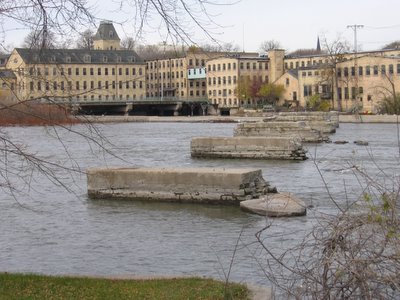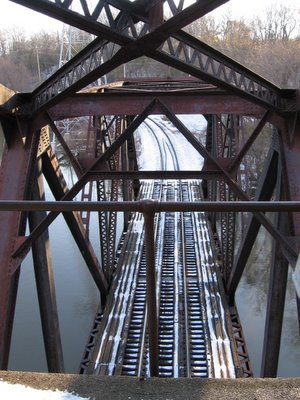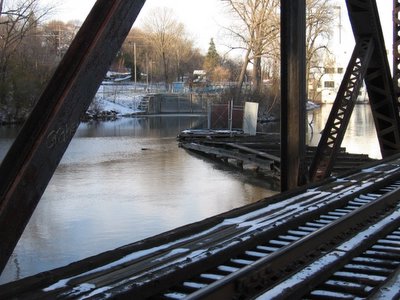
I'm stuck in a nostalgia wormhole lately (between bouts of despair about politics). I haven't figured out if it's the setting that puts me in this frame of mind, or if my natural predilection for the past makes these things attractive when they otherwise might not be. But here we are.
The single defining geographical feature of Appleton is the Fox River. This North-flowing river connects Lake Winnebago to the Green Bay of Lake Michigan some 30 miles or so away. While this part of Wisconsin is quite flat, the river has cut its way thru Appleton leaving some rather high bluffs. And actually, the gradient along the Fox River is quite steep, lending it (as was duly noted a hundred years ago) to industry and power generation. Thus this area became known as the "paper valley," because of the concentration of paper mills along the river, papermaking being an industry with a voracious appetite for both water and energy.
Anyway, in a process that mirrors that of countless other communities across the country, the industry has gradually dried up, and the river has become as much a recreational and atmospheric presence as a utilitarian and industrial one. Quite a number of paper mills remain, but as many have closed, in some cases leaving behind hulking empty warehouses and other industrial residue.
Somehow, it is the flotsam and jetsam of industry that speaks loudest to me of days gone by. Industrial design is typically more honest, more a function of how advanced the technology is rather than what is considered stylish or aesthetically attractive. These industries of days past often involved very different job descriptions and engendered different lifestyles than today, the bone marrow of nostalgia. No industry captures all this better than the railroad, and Appleton for its size seems satisfyingly rich in railroad history. It's one of my points of attachment to the city, and evidence of the railroads' heyday and decline are everywhere. A flat section in my own yard down the hill from the house was used many decades ago for a railroad siding; so old steam trains used to idle in my back yard! This all seems impossibly romantic to me, though doubtless having trains in one's yard would be a nightmare for most people! From my kitchen windows I see and hear trains pulling up a steep grade across the river several times a day.
I walk most days along the river, and there are still a few active railroad tracks that follow the Fox, connecting the series of paper mills along its length. But I'm more particularly drawn to the tracks no longer in use, and to the more subtle evidence of what used to be. There are still a few bridges crossing the river between abandoned mills, some with tracks in place and others with the tracks long since pulled up. A number of pilings mark where bridges used to be, now long since removed altogether. All along the remaining railroads, turnouts lead to weed-choked spurs, or to a row of ties where a spur used to be. Each speaks of some lost little bit of history.

A regular destination of my walk, though, serves as a delicious combination of what remains and what has been. An old trestle bridge a mile or so upriver remains in daily use, just downstream from one of the Fox's many lock & dam combinations. (Most of these 25 or so locks are out of commission for some years, but a private group is gradually restoring them, which will again enable navigation along the river.) It is a huge rusting structure, heavy enough to have supported fully loaded trains for probably 75-80 years with what appears to be minimal maintenance. It is made wistfully beautiful by its rude, ugly, defiant utility.
But what is most interesting to me is that the bridge used to rotate out of the way to allow boats to pass (it sits only 8-10 feet off the water so no boat of any size can go under it). The heavy trestle structure of the bridge is thus intended not only to support trains that pass over the bridge, but also to keep the bridge rigid as it pivots its hundreds of tons on what must be a gigantic central bearing, the ends swinging away from terra firma and suspended free over the water as it rotates. The remains of a support trellis made, it appears, of railroad ties protrudes out of the water, intended to support the bridge when it was in the "open" position. The railroad tie structure is badly damaged by ice and many years under water, but still shows where the rotated bridge would rest while it waited for boats to pass. The bridge has very clearly not rotated for, I would guess, 50 years or more (which leads me to wonder when the final operation of this function was performed and whether anyone knew it was the last such operation).

On the top of the bridge in the center there is a small shack, obviously for the bridge operator to do his work. I decided today to be bold and climb the rickety iron stairs up three or four stories to look at this shack (I noticed that the door was ajar as I walked across the bridge). The shack was a single room, about 12 feet square, with walls of paneled wood and corrugated metal, with about an eight foot ceiling. The floor, some six stories off the water, was of poured concrete. The room had three windows, one boarded up and the other two broken. The view out the windows downriver was breathtaking. And along the North wall inside was the huge mechanism used to rotate the bridge, consisting of a six-cylinder flathead car engine and transmission (with standard H-pattern gearshift in plain view) running a bunch of massive, solid steel gears and pinions, all controlled by a couple giant-sized foot pedals and three or four huge iron levers sticking up five feet out of the floor. A gasoline tank for the engine was bolted to the heavy handrailing outside the building. Again, it was clear at a glance that someone had locked the door on this machinery many, many years ago and it had not functioned since. Everything was covered with bird droppings and a thick layer of dust.

My mind whirls at this setting. Somebody designed and installed this stuff--it was brand new once--and it was somebody's job for years to maintain and operate this bridge (file this under Strange Job Descriptions). Somewhere there must be records of who held this job and at what pay. Is there anyone left alive who once operated the bridge? Does anyone even know how to do it? Are there documents in a file cabinet somewhere about the details of bridge operation? And if not, who made the decision that those skills would no longer be needed? What qualifications did it take to get the job of bridge operator? Did people interview for it? Did they have other duties? Or did someone man that booth 12 hours a day? Year round? Or just during summer months? (The river does not freeze solid everywhere, but navigation by boats was surely hampered during the winter months.) Was there heat in there at one time? How did one communicate with the bridge operator? Mundane questions, I know, the kinds of stuff a pilot might ask; but the answers add up to something just out of reach now, something lost in the fog of time.
Anyway, here's a little glimpse of the state of things today, near the end of a long and useful life. This is our nostalgia tour for today.




8 comments:
Great post. "...which leads me to wonder when the final operation of this function was performed and whether anyone knew it was the last such operation." How applicable this is to so many things in our lives. If we knew it would be the last time, would we have done things differently?
I'm right there with you. I have to think these last times sneak up on us unawares; otherwise, we approach them with some fanfare. I was actually going to go to the Outagamie County Historical Society today to see if I could dig up some more data about my bridge. Alas, they're closed Mondays :-(
And to inject the requisite neuroticism into the discussion, I have to wonder if it says something unhealthy about me that I'm more attracted to what we have moved on from than to what we're living today.
I like the idea of living among such nostalgic things. When I lived in NYC, obviously there was a lot of such things everywhere but they're all mixed up with whatever latest skyscraper Trump is building so they're easy to overlook. You have it right in your backyard though. That's very cool.
Are those pictures recent? It looks ridiculously cold.
Pics are from two days ago. There's a little bit of lingering snow, but it's above freezing--probably about 38-40° or so. Not too cold (at least compared to what's coming!).
What a beautiful and thoughtful post :)
Very interesting. I liked the pics.
That was fascinating. It this high-tech world, it is easy to forget the engineering skill that went into building bridges like that. I don't know why the rail is still a viable form of transportation in every other country rather than ours.
I have often pondered, in my transportation nerd kinda way, the same thing. And I think it boils down to population density and culture. Where we find dense populations--Europe, or parts of Asia, or in this country the Northeast corridor, or most major metro areas--we see trains working and thriving (relatively speaking); to take an extreme example, it's folly for most people to drive a car in New York City.
But in my region of the country there just isn't enough steel to connect all the scattered pockets of population by rail. We're simply too diffuse to make public transportation of this stripe work.
But beyond this, I think the country has really grown up, in the industrial revolution sense, around the automobile. Chicken and egg, I know. But the lure of a distinctly American type of travel--think Route 66--has imbedded itself in our collective psyche. And with that starting point we've now evolved to using our cars to accomplish what we want NOW, without planning or forethought. A different path followed downstream a ways.
The coming of age of China will test the viabilities of these philosophies.
Post a Comment